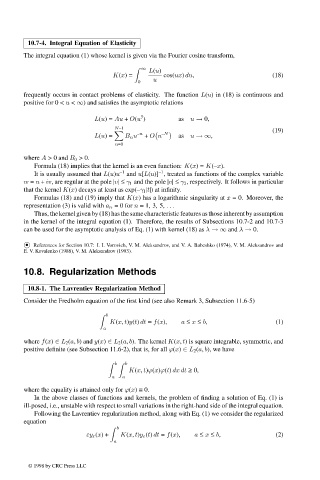Page 542 - Handbook Of Integral Equations
P. 542
10.7-4. Integral Equation of Elasticity
The integral equation (1) whose kernel is given via the Fourier cosine transform,
∞ L(u)
K(x)= cos(ux) du, (18)
0 u
frequently occurs in contact problems of elasticity. The function L(u) in (18) is continuous and
positive for 0 < u < ∞) and satisfies the asymptotic relations
3
L(u)= Au + O(u ) as u → 0,
N–1
(19)
L(u)= B n u –n + O u –N as u →∞,
n=0
where A > 0 and B 0 >0.
Formula (18) implies that the kernel is an even function: K(x)= K(–x).
–1
It is usually assumed that L(u)u –1 and u[L(u)] , treated as functions of the complex variable
w = u + iv, are regular at the pole |v|≤ γ 1 and the pole |v|≤ γ 2 , respectively. It follows in particular
that the kernel K(x) decays at least as exp(–γ 1 |t|)atinfinity.
Formulas (18) and (19) imply that K(x) has a logarithmic singularity at x = 0. Moreover, the
representation (3) is valid with a n = 0 for n =1, 3, 5, ...
Thus, the kernel given by (18) has the same characteristic features as those inherent by assumption
in the kernel of the integral equation (1). Therefore, the results of Subsections 10.7-2 and 10.7-3
can be used for the asymptotic analysis of Eq. (1) with kernel (18) as λ →∞ and λ → 0.
•
References for Section 10.7: I. I. Vorovich, V. M. Aleksandrov, and V. A. Babeshko (1974), V. M. Aleksandrov and
E. V. Kovalenko (1986), V. M. Aleksandrov (1993).
10.8. Regularization Methods
10.8-1. The Lavrentiev Regularization Method
Consider the Fredholm equation of the first kind (see also Remark 3, Subsection 11.6-5)
b
K(x, t)y(t) dt = f(x), a ≤ x ≤ b, (1)
a
where f(x) ∈ L 2 (a, b) and y(x) ∈ L 2 (a, b). The kernel K(x, t) is square integrable, symmetric, and
positive definite (see Subsection 11.6-2), that is, for all ϕ(x) ∈ L 2 (a, b), we have
b b
K(x, t)ϕ(x)ϕ(t) dx dt ≥ 0,
a a
where the equality is attained only for ϕ(x) ≡ 0.
In the above classes of functions and kernels, the problem of finding a solution of Eq. (1) is
ill-posed, i.e., unstable with respect to small variations in the right-hand side of the integral equation.
Following the Lavrentiev regularization method, along with Eq. (1) we consider the regularized
equation
b
εy ε (x)+ K(x, t)y ε (t) dt = f(x), a ≤ x ≤ b, (2)
a
© 1998 by CRC Press LLC
© 1998 by CRC Press LLC
Page 524

